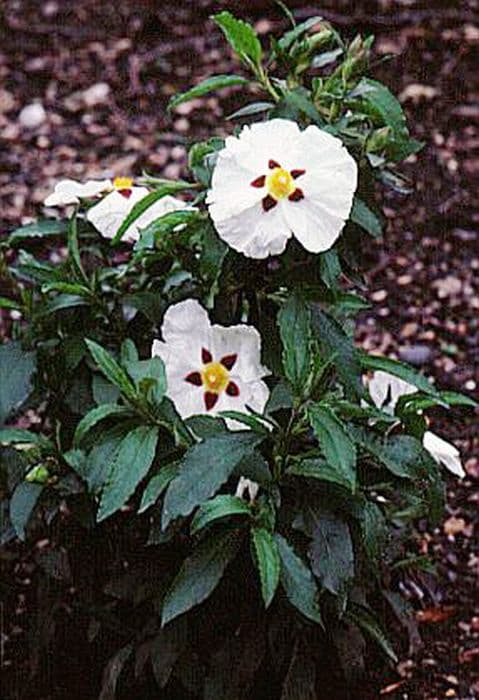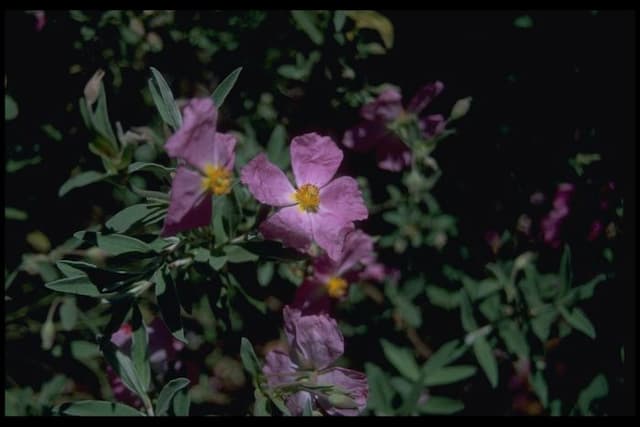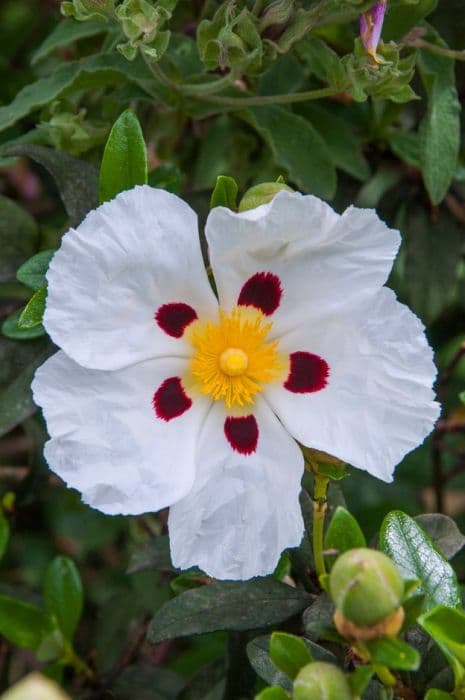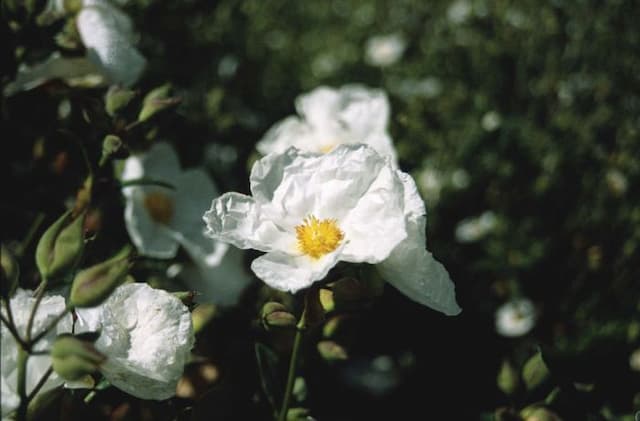Rock Rose Helianthemum 'Cerise Queen' (d)

ABOUT
The Helianthemum 'Cerise Queen', commonly known as Rock Rose, is a radiant, evergreen sub-shrub known for its decorative qualities. The plant is clothed in small, lance-shaped, green leaves that provide a dense, low-growing foliage. The Rock Rose blooms prolifically with vibrant, cerise-pink flowers. Each flower is composed of five rounded petals that delicately unfurl to reveal a sunny yellow center, creating a stunning contrast against the pink. The blossoms are known for their silky texture and are dotted with a prominent array of stamens that give an additional visual interest. Flowering occurs in an impressive display during the late spring to early summer, which provides a flush of color and is often a magnet for pollinators such as bees and butterflies. The plant's overall appearance with its mounding habit, resplendent blossoms, and evergreen leaves make it a desirable choice for gardeners looking to add a burst of color to their landscapes.
About this plant
 Names
NamesFamily
Cistaceae
Synonyms
Rock Rose, Sunrose, Rushrose
Common names
Helianthemum 'Cerise Queen'
 Toxicity
ToxicityTo humans
The Rock Rose 'Cerise Queen' is not known to be toxic to humans. Therefore, ingesting parts of this plant is not typically associated with poisoning or harmful effects.
To pets
The Rock Rose 'Cerise Queen' is also not known to be toxic to pets. It is not commonly associated with poisoning, and ingestion of the plant does not typically result in harmful symptoms or consequences in animals.
 Characteristics
CharacteristicsLife cycle
Perennials
Foliage type
Evergreen
Color of leaves
Green
Flower color
Pink
Height
1 foot (30 cm)
Spread
1 foot (30 cm)
Plant type
Shrub
Hardiness zones
5
Native area
Mediterranean
Benefits
 General Benefits
General Benefits- Attracts Pollinators: The vibrant flowers of the Rock Rose are excellent for attracting bees and butterflies, promoting biodiversity in the garden.
- Drought Tolerance: Once established, the Rock Rose is highly resilient to dry conditions, making it ideal for xeriscaping and water-wise gardening practices.
- Low Maintenance: It requires minimal care once established, with no need for regular watering or fertilizing, making it suitable for novice gardeners.
- Ground Cover: With its spreading habit, the Rock Rose can cover bare spots in the garden, reducing soil erosion and suppressing weeds.
- Decorative Use: Its bright, cheerful flowers and evergreen foliage make it an attractive addition to rockeries, borders, and containers.
- Seasonal Interest: Rock Rose offers a long blooming season, providing color and interest in the garden from spring to summer.
- Wildlife Habitat: The dense foliage provides shelter for small wildlife, creating a micro-habitat within the garden.
- Soil Improvement: As a hardy plant, the Rock Rose can help stabilize and enhance the soil in challenging garden spots.
- Resilience to Pests: The plant is generally resistant to pests, reducing the need for chemical treatments in the garden.
 Medical Properties
Medical PropertiesThis plant is not used for medical purposes.
 Air-purifying Qualities
Air-purifying QualitiesThis plant is not specifically known for air purifying qualities.
 Other Uses
Other Uses- Rock Gardens: Due to its compact nature and low-growing habit, 'Cerise Queen' is perfect for adding a splash of color between stones in rock gardens.
- Butterfly Attraction: The vibrant flowers of this plant can attract butterflies, providing not just beauty but also supporting local biodiversity.
- Garden Borders: Its vibrant pink blossoms can neatly define the edges of garden beds or pathways.
- Photography Prop: The bright blossoms of 'Cerise Queen' make it an ideal subject for nature photography, especially macro photography.
- Dry Flower Arrangements: The flowers can be dried and used to create long-lasting floral arrangements.
- Slope Stabilization: Its root system can help control erosion on slopes when planted in groups.
- Fairy Gardens: Its small size and colorful flowers make 'Cerise Queen' suitable for whimsical fairy garden designs.
- Educational Tool: It can be used in educational settings to teach children about plant life cycles and the importance of pollinators.
- Companion Planting: 'Cerise Queen' can be used in vegetable gardens to attract pollinators which are beneficial for crops.
- Creative Landscaping: Can be included in thematic garden designs, such as a pink-themed garden or a princess-themed children's garden.
Interesting Facts
 Feng Shui
Feng ShuiThe Rock Rose is not used in Feng Shui practice.
 Zodiac Sign Compitability
Zodiac Sign CompitabilityThe Rock Rose is not used in astrology practice.
 Plant Symbolism
Plant Symbolism- Endurance: As a member of the rockrose family, Helianthemum 'Cerise Queen', commonly known as the 'Sunrose', is tolerant to drought and tough conditions, symbolizing the ability to persist and endure hardships.
- Optimism: The bright, cerise pink flowers are a visual metaphor for positivity and cheerfulness, representing an optimistic outlook on life.
- Adaptability: The Sunrose's ability to thrive in poor, rocky soils signifies adaptability to different situations and environments.
- Attraction: With its vibrant hues, the plant symbolizes attraction and the ability to garner attention.
 Water
WaterRock rose 'Cerise Queen' prefers dry to medium moisture levels and does not tolerate overwatering well. It's best to water this plant when the top inch of soil feels dry to the touch. Generally, watering once a week during active growth periods should suffice, but this may vary depending on climate, weather conditions, and soil drainage. Provide about one gallon of water per plant, ensuring it's applied directly to the base and avoiding wetting the foliage to prevent fungal diseases. During the dormant season, reduce watering frequency to every two to three weeks or as needed to prevent the soil from becoming completely dry.
 Light
LightRock rose 'Cerise Queen' thrives best in full sun to partial shade. It should be placed in a spot where it can receive at least six hours of direct sunlight daily. Although partial shade is tolerable, especially in areas with very hot summers, full sun exposure encourages better blooming and optimal growth for this sun-loving plant.
 Temperature
TemperatureRock rose 'Cerise Queen' is adapted to a wide range of temperatures but performs best in climates with warm summers and cool winters. It can typically withstand temperatures as low as 10 degrees Fahrenheit and as high as 100 degrees Fahrenheit, with ideal conditions being between 60 to 85 degrees Fahrenheit. This plant is quite hardy but may require protection in areas where temperatures drop below 10 degrees.
 Pruning
PruningRock rose 'Cerise Queen' benefits from light pruning to maintain its shape and promote more vigorous growth and flowering. Prune immediately after the first bloom in early summer, cutting back the spent flowers and about a third of the plant's height. Annual pruning will help prevent the center from becoming woody and encourage fresh growth and better blooms the following season.
 Cleaning
CleaningAs needed
 Soil
SoilRock Rose 'Cerise Queen' thrives in well-draining soil with a pH of slightly acidic to neutral, about 6.0 to 7.0. Mix equal parts of sand, peat, and loamy garden soil to create an ideal environment. Avoid waterlogging to prevent root rot.
 Repotting
RepottingRock Rose 'Cerise Queen' is typically repotted every two to three years or when it outgrows its container. Check annually and repot in spring if necessary, using fresh soil mix to replenish nutrients.
 Humidity & Misting
Humidity & MistingRock Rose 'Cerise Queen' prefers low to moderate humidity levels and can tolerate dry air well. It is suited to typical outdoor conditions and doesn’t require specific humidity adjustments.
 Suitable locations
Suitable locationsIndoor
Place in bright, direct sunlight.
Outdoor
Full sun, sheltered from strong winds.
Hardiness zone
5-8 USDA
 Life cycle
Life cycleThe Rock Rose 'Cerise Queen' (Helianthemum 'Cerise Queen') starts its life cycle as a seed, which, when sown in well-draining soil and with enough warmth and light, will germinate. As a seedling, it requires consistent moisture without waterlogging, and it begins to establish a root system and foliage. During the vegetative stage, the Rock Rose 'Cerise Queen' grows rapidly, developing a woody base, grey-green leaves, and preparing for flowering. The plant reaches maturity and enters the blooming phase in late spring to summer, displaying vibrant cerise-pink flowers that attract pollinators and aid in reproduction. After pollination, the flowers fade, and the plant produces small capsules containing seeds, thus completing the reproductive cycle. The Rock Rose 'Cerise Queen' is a perennial, so it enters a period of dormancy in autumn and winter, during which it conserves energy before starting its cycle anew in spring.
 Propogation
PropogationPropogation time
Spring to Summer
Propogation: The 'Cerise Queen' Rock Rose is most commonly propagated through semi-hardwood cuttings. The ideal time to take these cuttings is in late summer, after the blooms have faded and the current season's growth has started to mature but hasn't yet become tough and woody. To propagate by this method, a gardener would select a healthy, non-flowering stem and cut a piece around 4 to 6 inches (10 to 15 centimeters) long, making sure it includes several leaf nodes. The lower leaves are then stripped, and the base of the cutting is dipped in rooting hormone before being planted in a sterile, well-draining potting mix. The cuttings should be kept moist and in a warm, but not hot, environment with indirect sunlight until roots have established, after which they can be potted up or planted out depending on the season and local climate conditions.









